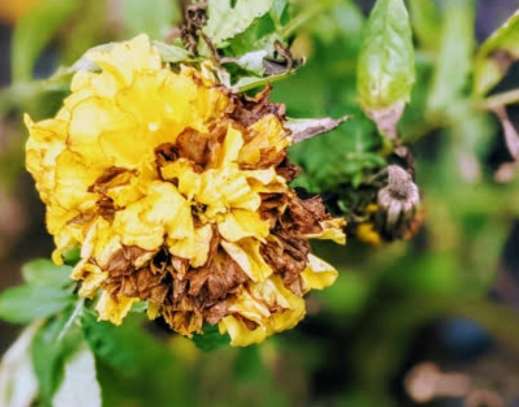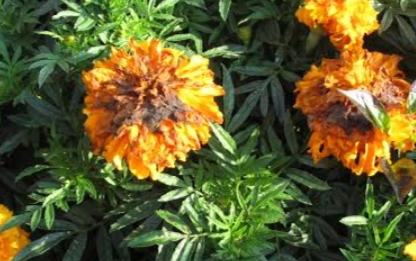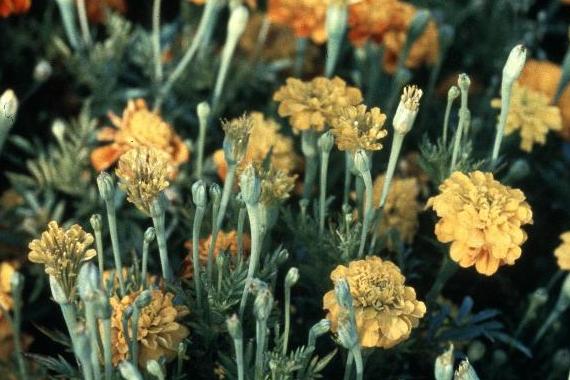Marigold Plant
Marigold, also known as Tagetes, is an outdoor flowering plant. Plant in well-draining soil with full sun exposure. Water consistently, and deadhead spent flowers for continuous blooming. Pruning helps maintain a compact and bushy appearance.
Habit
Annual
Height
0.3 to 0.6 m
Growth
Fast
Soil
Well-drained, Loamy
Shade
Full Sun
Moisture
Moist
Edible
No
Medicinal
No
Origin
Mexico, Central America
Climatic Condition
Tropical, Subtropical
Temperature (°)
15°C to 30°C
Humidity (%)
60% to 70%
Potting media
50% Loam, 40% Sand, 10% Compost
Fertilizers
Organic Fertilizer
Watering
Regular watering
Plant Weight
0.2 to 0.4 kg
Flowering Time
Spring to Summer
Soil Ph level
6.0 to 7.5
Water Ph level
6.0 to 7.0
Soil EC
0.5 to 1.0 mS/cm
Yield Per Plant
1 to 3 kg per plant
NPK ratio
10:10:10
life Span
1 to 2 years
Health Benefits
Ornamental, Pest Repellent
Suggested Grow Media or Potting Mix ?
50% loamy soil, 30% compost, 20% sand
Suggested Fertigation/Fertilizers
Fertilize every 2 weeks with a balanced fertilizer.
Common Diseases and Remedies
Alternaria leaf spot , Collor rot
Brown necrotic spots formed on leaves , premature defoliation , black lesions develop on the main stem.
Mix of mild liquid soap on the water , Avoid water logging conditions .
HEALTH BENEFITS
- Rich in lutein, supporting eye health and vision
- Anti-inflammatory and antibacterial, beneficial for skin conditions
- Boosts wound healing and can be used in herbal teas
What Is An Marigold ?
Marigold, academically known as Tagetes, is a popular annual plant highly valued for its bright, cheerful flowers and its ability to repel garden pests. Marigolds come in a variety of sizes, from compact to tall, and come in flower colours such as yellow, orange, and red, and are easy to grow, preferring sunlight and well-drained soil. It is often used as a border plant, in containers, or as a companion plant to avoid pests such as aphids and mosquitoes.

What Are The Different Types Of Marigold ?
1. African marigold (Tagetes erecta)
A tall, hardy plant with large, full blooms of yellow, orange and red.
2. French marigold (Tagetes marigold)
French marigolds have shorter, bushier growth and small flowers in a wide range of colours, including bicolored varieties.
3. Signet marigold (Tagetes tenuifolia)
Signet marigold has small, delicate leaves and clusters of small single flowers. Often used as a border plant or container.
4. Triploid marigolds
These are hybrid marigolds that are a cross between African marigolds and French marigolds, combining the size and vigour of African marigolds with the wide range of colours of French marigolds.

How to Care Marigold Plant ?
1. Location
Marigolds grow in full sunlight. This means they need at least 6 to 8 hours of direct sunlight per day. Choose a spot in your garden or landscape with plenty of sunlight and well-drained soil. Marigolds are not selective about soil type, but prefer fertile, well-drained soil. Marigolds are prone to root rot if they get too wet, so avoid planting them in areas with poor drainage. Additionally, marigolds are often used as border plants in flower beds and containers. Therefore, when planting, take into account the aesthetic and practical aspects of the chosen location.
2. Sunshine
Marigolds thrive in full sun and require at least 6 to 8 hours of direct sunlight per day for healthy growth and flowering. For optimal growth and flowering, plant in a location that receives full sunlight throughout the day. If possible, choose a location that receives morning sunlight. This will dry the dew from the leaves and reduce the risk of fungal diseases.
3. Soil
Marigolds prefer fertile, organic-rich, well-drained soil. Well-drained, loamy soil is best for marigolds. It tolerates a variety of soil types, including sandy and loamy soils, as long as it drains well. Before planting, you can enrich the soil with compost or well-rotted manure to improve fertility and structure. Avoid planting marigolds in waterlogged or compacted soil, as this can cause root rot and poor growth. Additionally, slightly acidic to neutral soil pH (approximately 6.0 to 7.0) is suitable for marigold plants.
4. Hydration
Marigold plants prefer moderate water. This means that you need to water evenly and not excessively. Marigolds can tolerate short periods of drought, so wait until the soil dries out a little between waterings. However, it does not tolerate moisture or damp conditions as it can cause root rot and other problems. When watering, make sure to evenly moisten the soil around the roots to avoid waterlogging. During hot, dry periods, you may need to water more frequently to keep the soil evenly moist. Adding a layer of mulch around your plants will help retain moisture in the soil and reduce watering frequency.

5. Nourishment
Marigolds benefit from regular fertilization for healthy growth and abundant blooms. Before planting, you can incorporate organic matter, such as compost or well-rotted manure, into the soil to provide important nutrients to the soil. During the growing season, marigolds can be fertilized with a balanced fertilizer, such as a 10-10-10 or 5-10-5 formula, according to the manufacturer's instructions. Be careful not to apply too much fertilizer as this will cause the leaves to grow too long and flower production to be poor.
6. Issues
Marigolds can attract pests such as aphids, spider mites, and caterpillars. Inspecting plants regularly and using insecticidal soap or neem oil can help control pest infestations. The most common diseases that affect marigolds include powdery mildew, botrytis, and root rot. To prevent these diseases, avoid overhead watering, improve air circulation, and avoid planting marigolds in overly wet or compacted soil. Fungal diseases can be treated with fungicides. Marigolds prefer well-drained soil, and constant overwatering can cause root rot. Wait until the soil is slightly dry between watering and avoid overwatering.
What are the Benefits of Marigold Plant ?
Marigolds add beauty and visual interest to gardens, landscapes, and flower arrangements with their vibrant blooms in shades of yellow, orange, and red. Marigolds have traditionally been used medicinally in various cultures, including to treat minor skin irritations, wounds, and irritations. These contain compounds with antibacterial and anti-inflammatory properties. Marigold petals are edible and can be used to garnish salads, desserts, and drinks. It adds colour and a slightly spicy flavour to dishes. Marigolds produce nectar-rich flowers that attract bees, butterflies and other pollinators to your garden, promoting biodiversity and increasing fruit and vegetable yields. Marigolds are easy to grow and relatively low-maintenance plants, making them a good choice for novice gardeners or those with limited gardening time.

FAQs About Growing Marigold
1. Can marigolds be grown indoors ?
Yes, marigolds can be grown indoors, but they usually grow better outdoors in full sunlight. If you're growing marigolds indoors, make sure they get at least 6 to 8 hours of direct sunlight per day or provide supplemental artificial lighting. Also, make sure your soil is well-drained and water your plants regularly, allowing the soil to dry out a little between waterings. With proper care, marigolds can be successfully grown indoors as decorative houseplants or for their vibrant blooms.
2. How long do marigolds typically bloom ?
Marigolds typically bloom throughout the growing season, which can last from early summer until the first frost in fall, depending on your climate. With proper care and removal of spent inflorescences, marigold plants can bloom consistently for several months. However, individual flowers typically last about 4 to 6 weeks before fading and being replaced by new flowers.
3. Can marigolds be used as companion plants in the garden ?
Yes, marigolds are often used as companion plants in the garden. The compounds it produces, such as limonene and alpha-terthienyl, have natural pest repellent properties that can deter pests such as nematodes, aphids, and other harmful insects.
4. What are marigold flowers commonly used for in traditional medicine and cosmetics ?
Calendula has anti-inflammatory and antibacterial properties and can be used to treat minor cuts, burns, and skin irritations. It is suitable. It is often used in ointments, creams, and ointments for wound healing. Calendula can help relieve symptoms of skin conditions such as eczema, psoriasis, and dermatitis due to its soothing and calming effects on the skin.
5. How do I propagate marigolds ?
Marigolds are usually grown from seeds. Collect seeds from mature flowers once dry on the plant. Sow the seeds directly in well-drained soil in your garden, or sow them indoors in pots. Keep the soil moist until the seeds germinate. Germination usually takes about 5 to 7 days. Marigolds can also be propagated by cuttings. Take cuttings about 3 to 4 inches long from healthy, mature plants and make sure they have at least one set of leaves. Remove the lower leaves and soak the cut end in rooting hormone (optional). Plant cuttings in moist potting soil or rooting medium and store in a warm, bright place.



